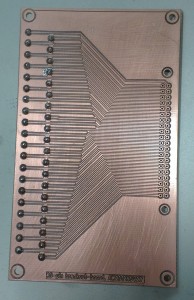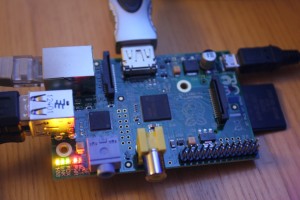Making break-out boards is not exactly rocket science... Oh well, this one is required for a 10-channel temperature measurement which we do with pt100 sensors and a 4-wire multimeter. It's great however to have a working toolchain where you come up with an idea in the morning, spend a few hours designing the schematic and PCB, then go over to the PCB-mill and run the CAM-programs to produce the PCB, and assemble and test your circuit by the end of the day.
Month: November 2012
Raspberry Pi
Out of curiosity and with a couple of different projects in mind I have been playing with a Raspberry Pi (a cheap, small, but slow linux computer) lately. Some observations:
- It's small, but it does require quite a few bulky connectors that connect to three different sides of the board. If you wanted to enclose the board and cables in a case the connectors add a significant amount to the footprint.
- Who came up with the idea of offsetting the two USB-connectors so they extend out of the board? This makes all the cases for the Pi have a funny shape to get the Ethernet and USB connectors flush with the side of the case.
- It seems to run the raspbian distribution OK. But for a standard debian-desktop it's very slow. There are optimized lightweight X-environments that are supposedly faster and more responsive.
- Since it's an ARM processor, not every package I am used to using on Ubuntu/Debian is available from the repositories.
- The modern way to interact with a gadget nowadays is a touchscreen. But there doesn't seem to be any good consensus on what touchscreen to use with the Pi. Could we have something budget-priced with good existing drivers for both screen and touch please. Perhaps use the DSI-connector so the gadget screen won't tie up other resources (USB, HDMI, SPI, or GPIO).
Overall this means my ideas for various real-time instruments & gadgets may be better served by an Atom ITX-sized motherboard. The atom is a standard x86 architecture that runs everything a desktop or laptop will run. It's fast enough to run modern desktop environments. And it has a PCI or PCIE slot for e.g. a Mesa FPGA card. Given the cost of enclosures, (touch)screens, FPGAs, and the analog electronics I have in mind, it really will not matter much if the cost of the motherboard+cpu combo is 40 euros (Pi) or 140 euros (Atom). Someone suggested I'd have a look at BeagleBoard or BeagleBone, but right now I'm leaning towards the Atom.

